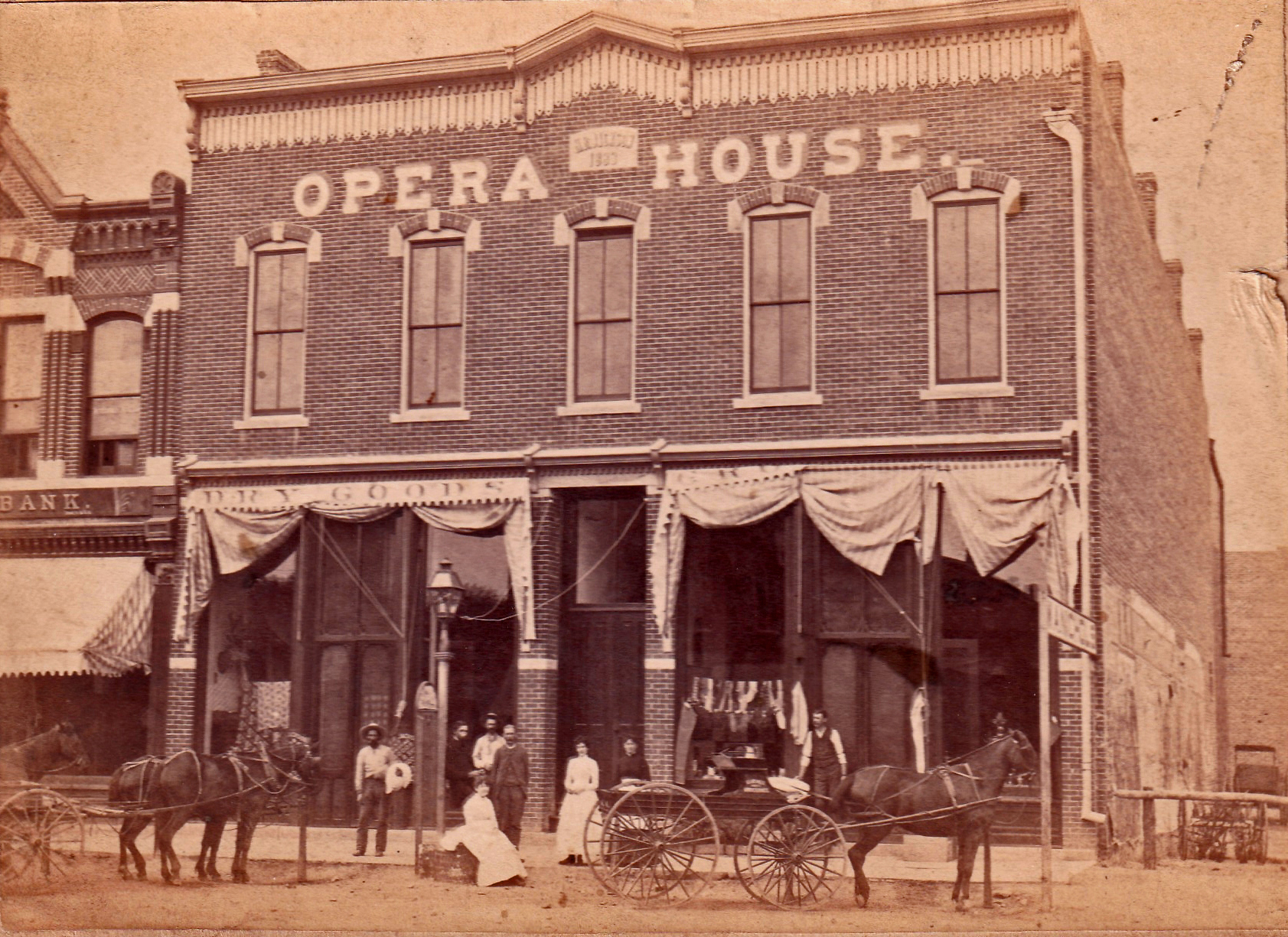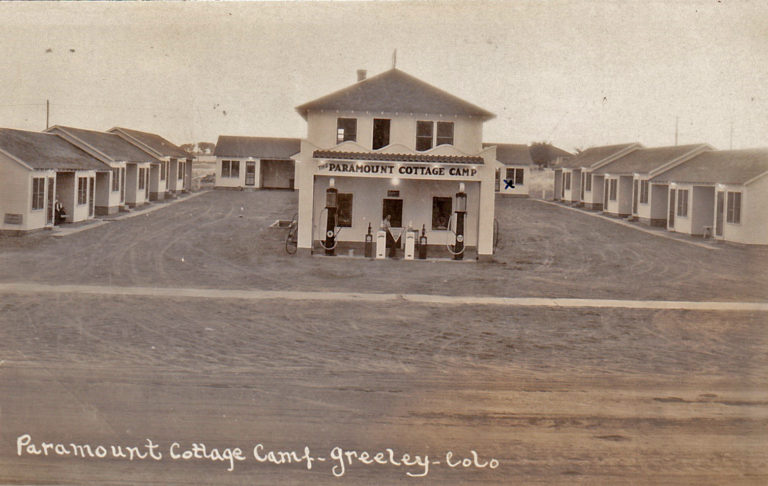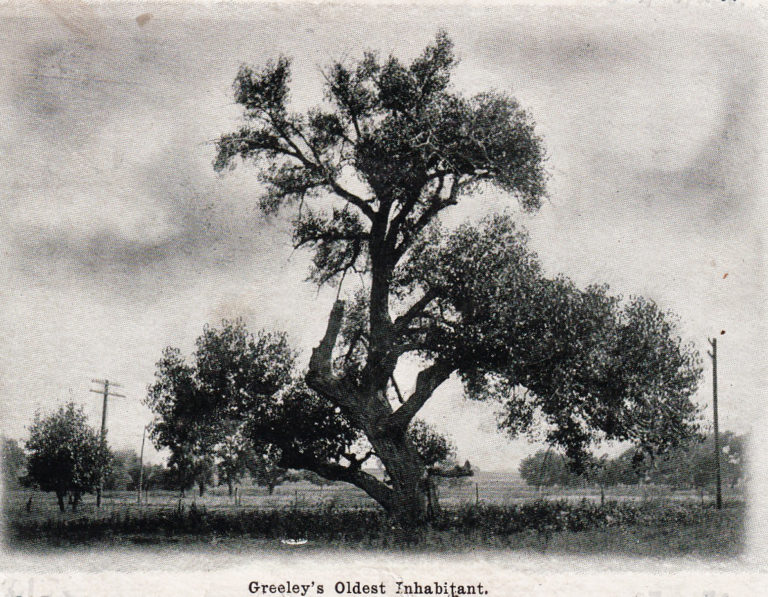On August 28, 1883, the citizens of Greeley witnessed the opening of Henry B. Jackson’s unique Eighth Avenue establishment. Built at a cost of $16,000, it combined a mercantile and grocery store on the ground floor with two large offices and an entertainment venue known as the Greeley Opera House on the top floor. (One of the offices at Jackson’s establishment was that of attorney W.A. Nichols – you can see the sign with his name on it jutting out toward the camera from the right corner of the building.) The building’s date stone reads “H. B. Jackson 1883.” Jackson, a New York native, and his wife, Lina, who hailed from Iowa, came out to Greeley in 1872, where Henry began working as a clerk in mercantile stores and eventually opened his own store.
Harry Miner’s 1884/85 edition of the American Dramatic Directory provides some details about Jackson’s opera house, citing its seating capacity for 400 people, a stage measuring 18 by 30 feet and three sets of scenery. Opera house staff included George W. Fisk, orchestra leader, R.S. Ferguson, bill poster, and teamster James Beetham.
Jackson worked with Greeley hotels, including the Oasis, the Exchange and the Colorado, to induce them to offer special rates for his theater patrons. In 1884, those rates ranged from $1.25 to $2.00 per night. [Here’s a photo link, circa 1890, for the 100-room, three-story Oasis, built at a cost of $85,000 and opened for business in 1881, just two years before Jackson’s Opera House opened: Oasis Hotel Greeley Colorado – Photographs – Western History – Denver Public Library Special Collections and Digital Archives Digital Collections (denverlibrary.org) . Seen posing in the foreground are members of the Rogers Brashi Bazooks drum and bugle corps out of Denver. The hotel sat on the northeast corner of 8th Avenue and 7th Street in what is now the parking lot immediately south of the State Armory Event Center. It was said by some to be the third best hotel in Colorado, after the Broadmoor in Colorado Springs and Denver’s Brown Palace. In 1906, Daniel Camfield would buy the Oasis, christen it the Camfield and add a fourth floor. It would serve patrons until it was razed in 1964.]
Henry Jackson knew his opera house would be competing with Barnum Hall, Greeley’s first civic auditorium. But Jackson had reason to be optimistic, for the hall had been receiving some bad press. The Rocky Mountain News reported in May of 1881 that the hall was undergoing repairs, but probably not to the degree needed to keep the hall in good order. Then, in January of 1883, approximately seven months before Jackson would open his opera house, the Fort Collins Courier reported that a Masonic festival and dance to be held in Barnum Hall had been indefinitely postponed due to safety problems there. The Greeley Tribune, extolling the virtues of Jackson’s new opera house, referred to Barnum Hall as “that old and miserable shell.”
Jackson’s optimism was warranted — his opera house replaced Barnum Hall as Greeley’s preferred indoor entertainment location (in fact, Barnum Hall would end up being razed in 1884) — but in 1886 he found a new competitor in Samuel D. Hunter. That year, Hunter constructed a three-story brick building on the southeast corner of Eighth Street and Eighth Avenue and dedicated the second floor to what would become the Greeley Opera House. The spaciousness of this new venue would leave Jackson’s in the dust. It featured seating capacity for 700, as opposed to Jackson’s 400; and what was said to be northern Colorado’s largest stage, measuring 2,376 square feet, thus dwarfing Jackson’s 540 square-foot stage. It even featured a “safe entrance” for women.
It’s not clear how much longer Jackson operated the opera house, but he retired from the mercantile business in 1888. After that he engaged in the produce business for a period of time, and around 1901 he took a job as manager for an oil company. This was cut short in the spring of 1902 when ill health forced him to retire, and he would pass away in March of 1903 at age 54. His remains are interred at Greeley’s Linn Grove Cemetery. His mercantile/opera house building no longer stands.
P.T. Barnum
The owner of Barnum Hall was American showman Phineas T. Barnum. A staunch advocate for temperance, Barnum was drawn to the Union Colony (the predecessor of present-day Greeley) because it held temperance to be one of its founding principles. This motivated Barnum to become a stockholder in the colony, which he would declare to be a “paradise protected by flaming swords of sobriety.”
Barnum never lived in Greeley but visited there on more than one occasion and built or bought at least 11 properties there, including property sold to him by his cousin and local agent, Union Colonist E.T. Nichols. One property he purchased from Nichols in 1875 would become the afore-mentioned Barnum Hall, a two-story building across the street from Lincoln Park on the northeast corner of Ninth Avenue and Eighth Street.
Barnum built two large rental houses in Greeley, located on Sixth Street between Seventh and Eighth Avenues, but when the high rents he asked proved unrealistic, he had the two houses connected and created a hotel known as the Barnum House. P.T.’s second oldest daughter, Helen, and her husband, William Buchtel, a physician whose practice at some point included obstetrics, would live at the Barnum House, where Buchtel also had his practice and operated a drugstore. Helen and William had moved to Greeley in 1871 shortly after Helen’s divorce from husband Samuel Hurd, who got custody of their three daughters.
William Buchtel’s writing of prescriptions for alcohol for “medicinal purposes” got him in hot water with Greeley officials and by family association put the squeeze on temperance champion Barnum. By the end of 1872, it became clear that, if legal action were to be taken against Buchtel, he would lose his practice and Barnum would lose his property holdings. So, Buchtel and his wife high-tailed it to Denver and never returned, which allowed P.T. to keep his investments. Several years later, Barnum sold his Greeley properties for a good profit.
Barnum also invested in land, purchasing several hundred acres west of Denver in 1878. In the early 1880’s, a subdivision would be platted on this land and given the name Barnum. When P.T. died in April of 1891 (leaving an estate reportedly worth $5,000,000) his bequeathal to Helen would include 765 acres of Colorado land, which almost certainly included land on which the town of Barnum would develop. Helen and her husband, William, would contribute significantly to the town’s development. In 1883, Helen guaranteed a $250,000 bond toward the sale of lots in the Barnum subdivision – the sales goal was a whopping 5,012 lots – and William was serving as mayor of Barnum when it was incorporated in 1887. (I was unable to determine how well the lots sold.)
In 1894, Helen would go head-to-head with Barnum town officials to protest the town’s tax assessment against her Barnum property to pay for new sidewalks. Helen’s lawsuit against Barnum in federal court asserted that the town authorities “have gone into new sidewalks by wholesale,” including laying sidewalk for eight blocks which did not yet contain houses. Helen maintained that the ordinance authorizing this tax was “illegal in many ways” and that building sidewalks before the permanent grade of the streets had been determined was premature. (Her lawsuit was reported in a Rocky Mountain News article titled “Sidewalks for Cottontails,” with the sub-title “Mrs. Buchtel Objects to Paving Prairie Land.”) The town responded, saying it would fight the Buchtel case “to the bitter end.” I could find no additional information about Helen’s lawsuit, but suspect that the town prevailed, as the town’s development was a goal shared by both parties.
The citizens of Barnum were eager to acquire the amenities of a modern community, such as paved roads and rail transportation, but experienced frustration with the city of Denver, which was perceived as uninterested in Barnum and its Westside neighbors. The perseverance needed by Barnum residents to attain their goals and the presence of Barnum’s characteristically mucky, poorly drained soil gave rise to the catchphrase, “If you stick with Barnum, Barnum will stick with you.”
In 1893, Barnum would get its rail connection to Denver in the form of the Denver, Lakewood and Golden Railroad, which transported passengers and freight. Helen was a key player in making this happen, having contributed $25,000 toward its construction. She made the contribution with the understanding that the railroad would provide half-hourly service to Barnum. After an economic depression set in that same year (it would continue through 1897), Helen offered to let the railroad serve Barnum on an hourly basis as long as they could show that it wasn’t profitable for them to run more frequently. In 1900, with the economy improved, Helen served notice to the railroad that its hourly service was injuring the value of her investment in the town lots and demanded the reinstatement of service on a half-hourly basis, but the railroad refused. Consequently, in 1901 Helen would file suit against the railroad in federal court, demanding resumption of half-hourly service and $5,000 in damages for its failure to provide service on that schedule during the previous seven years. But by this point in time, it was too late, for the economic downturn and the railroad’s loss of its Golden-Tindale branch in the Great Flood of July 24, 1896, resulted in bankruptcy for the line. (Tindale was a small, now defunct, coal mining company town north of Golden.) The line would subsequently be reorganized as the Denver & Intermountain Railway (D&IR). I could find no further information about Helen’s fight for better rail service to Barnum.
Barnum was annexed to Denver in 1896, and its post office would close in 1901. Today, Barnum is referred to as a Denver neighborhood, bounded by Sixth Avenue to the north, Federal Boulevard to the east, Alameda Avenue to the south and Perry Street to the west.
Helen Barnum Buchtel would pass away in December of 1915 at the age of 75, outliving William, who died in October of 1912 at age 67. Their remains are interred at Denver’s Fairmount Cemetery.
REFERENCES:
- “Asks Court to Compel Railway to Keep Promise,” The Rocky Mountain News dated December 7, 1901, Colorado Historic Newspapers Collection at https://www.coloradohistoricnewspapers.org/?a=d&d=RMD19011207-01.2.150&srpos=8&e=——-en-20–1–img-txIN%7ctxCO%7ctxTA-helen+barnum+buchtel——-0——
- “Barnum,” The West Side Citizen dated May 25, 1894, Colorado Historic Newspapers Collection at https://www.coloradohistoricnewspapers.org/?a=d&d=WSN18940525-01.2.14&srpos=4&e=–1894—1900–en-20–1–img-txIN%7ctxCO%7ctxTA-buchtel——-0——
- “Barnum Neighborhood History,” Genealogy, African American and Western History Resources, Denver Public Library at https://history.denverlibrary.org/barnum-neighborhood-history
- “Barnum’s Money,” The Colorado Daily Chieftain dated April 11, 1891, Colorado Historic Newspapers Collection at https://www.coloradohistoricnewspapers.org/?a=d&d=CFT18910411-01.2.19&srpos=12&e=——-en-20–1–img-txIN%7ctxCO%7ctxTA-helen+barnum+buchtel——-0——
- “Buchtel Babies Sought,” the Douglas County News-Press dated March 31, 1990, Colorado Historic Newspapers Collection at https://www.coloradohistoricnewspapers.org/?a=d&d=DNP19900331-01.2.18.1&e=——-en-20–1–img-txIN%7ctxCO%7ctxTA-helen+barnum+buchtel——-0——
- “Colorado Post Offices – 1859 to 1989,” by Bauer, Ozment and Willard, published in 1990 by the Colorado Railroad Museum.
- “Did you know that America’s ‘Circus King’ owned a building in Greeley named Barnum Hall?” Greeley Museums on Facebook at https://m.facebook.com/GreeleyMuseums/posts/2855944997774255?comment_id=2896641950371226&reply_comment_id=2905856396116448
- “Four Star Memories,” History of Weld at https://history.weldgov.com/County-150/Business/Four-Star-Memories
- “Funeral of H.B. Jackson,” The Greeley Tribune dated April 2, 1903,” Colorado Historic Newspapers Collection at https://www.coloradohistoricnewspapers.org/?a=d&d=TGT19030402.2.38&srpos=5&e=–1903—1903–en-20–1–img-txIN%7ctxCO%7ctxTA-henry+jackson+greeley——-0——
- “Greeley,” The Rocky Mountain News dated October 5, 1883, Colorado Historic Newspapers Collection at https://www.coloradohistoricnewspapers.org/?a=d&d=RMD18831005-01&e=05-10-1883-05-10-1883–en-20–1–img-txIN%7ctxCO%7ctxTA-greeley——-0——
- “Greeley Gatherings,” The Rocky Mountain News dated May 25, 1881, Colorado Historic Newspapers Collection at https://www.coloradohistoricnewspapers.org/?a=d&d=RMD18810525-01.2.25&srpos=4&e=–1881—1881–en-20–1–img-txIN%7ctxCO%7ctxTA-greeley+gatherings——-0——
- “Greeley Gleanings,” Fort Collins Courier dated January 4, 1883, Colorado Historic Newspapers Collection at https://www.coloradohistoricnewspapers.org/?a=d&d=FCC18830104.2.50&srpos=2&e=–1883—1883–en-20–1–img-txIN%7ctxCO%7ctxTA-greeley+gleanings——-0——
- “Greeley Had a Variety of Early Day Hotels, The Greeley Tribune dated April 3, 1970, Colorado Historic Newspapers Collection, www.newspapers.com at https://www.newspapers.com/image/25089163/?terms=greeley%20had%20a%20variety%20of%20early%20day%20hotels&match=1
- “Greeley Opera House Building Colorado cabinet card photo D. Lamon ca 1884,” ebay posting description, Colorado Artifactual, October 20, 2022.
- “G R E L E Y 8TH A V E N U E Comprehensive Historic Resource Survey at https://greeleygov.com/docs/default-source/community-development/historic-preservation/8th-avenue/greeley-8th-avenue-survey-report-final-draft.pdf
- “Harry Miner’s American Dramatic Directory for the Season of 1884 – ’85,” Harry Miner, Editor, Wolf and Palmer Dramatic Publishing Company, 1884, page 91, Google Books at https://books.google.com/books?id=azs_AQAAMAAJ&printsec=frontcover&dq=harry+miner%27s+american+dramatic+directory+for+the+season+1884&hl=en&newbks=1&newbks_redir=0&sa=X&ved=2ahUKEwiXk-jDq6z7AhUJAzQIHb1NA68Q6AF6BAgDEAI#v=onepage&q=jackson&f=false
- “Helen Maria (Barnum) Buchtel (1840 – 1915),” WikiTree at https://www.wikitree.com/wiki/Barnum-186
- Helen Maria Buchtel, U.S. Find a Grave Index at www.ancestry.com
- Henry B. Jackson, Find a Grave at https://www.findagrave.com/memorial/65224794/henry-b-jackson
- “Historic Hindsights: How P.T. Barnum helped shape early Greeley,” by Lenor Harriman, the Greeley Tribune dated May 13, 2020, at https://www.greeleytribune.com/2018/04/08/historic-hindsights-how-p-t-barnum-helped-shape-early-greeley/
- “Historical Hindsights: P.T. Barnum and the “Flaming Swords of Sobriety,” Greeley Tribune dated August 14, 2009, at https://www.greeleytribune.com/2009/08/14/historical-hindsights-p-t-barnum-and-the-flaming-swords-of-sobriety/
- “A Historical Quest for Entertainment,” History of Weld, Weld County, Colorado, at https://history.weldgov.com/County-150/Entertainment/Dullsville-U.S.A
- “Images of America – Greeley,” by Peggy Ford Waldo with the Greeley History Museum, 2016, Arcadia Publishing Company, Charleston, South Carolina.
- “Jackson Hall, Now Remodeled, Housed Numerous Road Shows,” the Greeley Tribune dated June 9, 1930, www.newspapers.com at https://www.newspapers.com/image/25009879/?terms=h%20b%20jackson
- Jackson obituary, The Fort Morgan Times dated March 27, 1902, Colorado Historic Newspapers Collection at https://www.coloradohistoricnewspapers.org/?a=d&d=FMT19030327-01.2.40&srpos=9&e=–1903—1903–en-20–1–img-txIN%7ctxCO%7ctxTA-h+b+jackson+greeley——-0——
- “Mile Markers in the History of the West Rail Line,” by Richard Gardner, Beyond Historically Jeffco at https://historicjeffco.files.wordpress.com/2013/10/westraillinetimelinerg.pdf
- “Mrs. Buchtel Objects to Paving Prairie Land,” The Rocky Mountain News dated May 22, 1894, Colorado Historic Newspapers Collection at https://www.coloradohistoricnewspapers.org/?a=d&d=RMD18940522-01.2.200&srpos=7&e=——-en-20–1–img-txIN%7ctxCO%7ctxTA-helen+barnum+buchtel——-0——
- “My dad (Will Searing) worked here, Jacksons store, Greeley, Colorado,” Denver Public Library Digital Collections at https://digital.denverlibrary.org/digital/collection/p15330coll22/id/6804
- “Oasis Hotel Greeley Colorado,” Denver Public Library Digital Collections at https://digital.denverlibrary.org/digital/collection/p15330coll22/id/8745/
- “Open Letter of Dr. Wm. H. Buchtel, Owner of Villa Park and Barnum’s Sub-Division,” the Rocky Mountain News dated August 15, 1883,” Colorado Historic Newspapers Collection at https://www.coloradohistoricnewspapers.org/?a=d&d=RMD18830815-01.2.86.4&srpos=22&e=——-en-20–21–img-txIN%7ctxCO%7ctxTA-helen+barnum+buchtel——-0——
- “Panic of 1893,” Wikipedia.org at https://en.wikipedia.org/wiki/Panic_of_1893
- “P.T. Barnum Builds Hotel in Greeley,” The Greeley Tribune dated April 3, 1970, www.newspapers.com at https://www.newspapers.com/image/25087859/?terms=p%20t%20barnum&match=1
- P.T. Barnum’s Opinion of Colorado,” Golden Weekly Globe dated March 22, 1873, Colorado Historic Newspapers Collection at https://www.coloradohistoricnewspapers.org/?a=d&d=GWG18730322.2.76&srpos=13&e=——-en-20–1–img-txIN%7ctxCO%7ctxTA-barnum+greeley——-0——
- “Tindale Coal Mine,” Golden History Museum and Park at https://www.goldenhistory.org/places/tindale-coal-mine/
- 1900 Census (www.ancestry.com)




